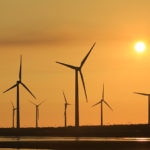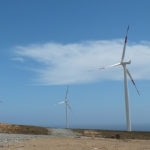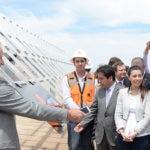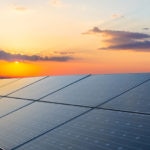Non-conventional renewable energies: a light that shines bright for Chile
In just a few years, Chile has left behind a power generation landscape dominated by conventional generation sources to become one of world’s top-investors in non-conventional renewable energy projects (NCRE) and one of the regional leaders in solar power technology. The boom is driven by factors such as an extensive coastline, a desert under recurrently clear blue skies and regulations that encourage operators

Historically, Chile has suffered from a shortage of fossil fuels in its geography, a fact that turned it into a country that depends on hydrocarbon and - to a lesser extent – coal imports. But nature did bless the country with other renewable resources, that have the potential to supply clean and renewable power.
Abundant winds and sunlight, an extensive coastline, volcano activity and organic matter - the leftovers from forestry and agroindustrial activities - have turned Chile into one of the most attractive countries for renewable energies investments. Indeed, the country has over 6,440 kilometers of windy coastline and is home to 137 volcanoes that power companies such as Italy’s Enel SpA and New Zealand’s Mighty River Power Ltd. rate highly due to the possibilities they offer for the installation of geothermal power plants.
Consulting firm EY recently ranked Chile fourth in in its renewable energy country attractiveness index. In fact, the long-term policy energy outlined by the Chilean government (Energy 2050), which was formalized last year, establishes that 60% of the power generation in the country must come from renewable sources by 2035. By 2050, this percentage should reach 70%.
Among renewable sources, the policy lends special relevance to non-conventional renewable energy (NCRE) projects, especially wind and solar projects. “Laws 20.257 and 20.698 defined a share of NCRE in the gross final energy consumption of free customers and regulated contracts. Based on this premise, by 2025, the percentage of NCRE generation should stand, at least, at 20%,” said Christian Santana, head of the Renewable Energy Division of the Ministry of Energy.
According to the same government official, over the course of the past year, the percentages required by law (which increase every year) doubled and even tripled in some months. In combination with the number of power plants projects under construction, these figures seem to indicate that the NCRE 20% goal defined for 2025 is very likely to be achieved much earlier.
According to the Ministry of Energy’s statistical data, a total of 51 projects in progress had been subject to environmental impact assessment as of May 2015, totaling 3,442 MW, a figure that translates into $9.4 billion. Out of this total, 46% corresponded to NCRE projects.
Sustainable boomThere are already many NCRE projects in operation today, most of them wind projects (897.24 MW), although in the case of solar power, combined, the projects that have already put into operation, connected ones and projects in testing stages add up to a total 1,217 MW. Also, there are more solar photovoltaic power plants being constructed and in environmental assessment stages than any other technology projects.
The truth is that the renewable energy explosion in Chile is of a scale such that it can be defined as an actual boom; a boom that is turning the country into the leader of Latin American's energy transition process, from a landscape dominated by conventional power sources towards NCRE. But the scenario was quite different a few years ago: in 2008 non-conventional renewable energies were absent in Chile’s energy matrix; in 2015, during the latest public bidding process that has taken place, these technologies surprised the market winning most contract awards. And without tax subsidies.
In mid-June, the Economic Commission for Latin America and the Caribbean (ECLAC) said that Chile can become a key renewable energy platform in the region, and praised the country’s leadership in boosting investments in the matter. Alicia Bárcena, executive secretary of the ECLAC, valued the determination of the Chilean government to overhaul the energy matrix by adopting policies aimed at encouraging the adoption of these power generation sources. The results are visible.
Anyone driving north along the Pan-American road towards La Serena region, will eventually run into the imposing view of the modern age “windmills", in reality the wind turbines that populate the wind farms that have started popping up all across Chile. One example is the 115 MW El Arrayán project, developed by Pattern Energy Group Lp, the largest wind farm in Latin America.

El Arrayán project.
Regarding solar power, U.S. company First Solar completed in late 2015 the construction of the 141 MW Luz del Norte (Northern Light) power plant, after investing approximately $370 million.

President Bachelet at First Solar Company in Chile
Another example is Spanish company Acciona, which started building the 247 MW El Romero Solar photovoltaic plant in the Atacama desert (3rd region), with an approximate investment of $343 million, one of the largest of its kind in the world. In this case, the project is partially funded by BBVA, which plays an active role in the energy industry.

El Romero Solar
Thanks to all this momentum, Chile has risen as one of the top ten countries by volume of investment in this field, with nearly $2.2 billion devoted to solar power, as reflected in “Global Trends in Renewable Energy Investment”, a paper drawn up by the United Nations Environment Program (UNEP), Bloomberg New Energy Finance and Frankfurt School.
Another annual report focusing on 55 countries, Climatescope, elaborated by the Department for International Development of the United Kingdom and the U.S. Agency for International Development, with the participation of Bloomberg New Energy Finance, also stated that Chile “is the leader in Latin America in solar installations.”
“Generators bid to supply electricity during a certain time block,” says the report, and adds that the country also encourages clean energy through total exemption from transmission taxes for renewable projects up to 9MW and partial exemption for projects of 9MW to 20MW.
Overhauling the energy matrix
In July a new bidding process will be concluded. Dozens of projects were originally submitted, which have been subject not only to an environmental assessment but also to a financial feasibility study issue by a risk rating agency. ICR is one of them, and according to Fernando Villa, an analyst that works at the firm, “fortunately, about 18% of the power that will be auctioned, corresponds to hourly blocks in which NCRE are competitive, and therefore provides a significant space for their development.”
Villa argues that, today, Chile is an attractive economy for NCRE, because it meets the basic climate requirements, especially regarding the availability of solar radiation and because, from a regulatory standpoint, the country is promoting this alternative. “This has translated into a surge in the number of new players that have taken part in the bidding processes for the supply of power to regulated customers. In the long term, this should guarantee a solid presence of NCRE, but in coexistence with other technologies.”
The prospects are excellent, and just as the trend seems to hint at, Chile’s energy matrix will be completely reshuffled over the course of the next decades. Christian Santana pointed out that Chile is positioned above the world’s average rates in terms of the estimate share of renewable energy in power generation (including all sorts of sources, including hydraulic) with 41% in 2015, compared to the world’s 23.7%. “The percentage will gradually increase until the 60% and 70% targets defined by the Energy Policy for 2035 and 2050, respectively, are achieved,“ he adds.
Challenges
However, there is still a number of challenges that need to be overcome, including the development of an infrastructure that allows to harness the enormous potential or renewable energies. In this field, banks such as BBVA have played an active role by funding projects linked to the construction of new power transmission lines that will allow to carry the energy generated by solar power plants and wind farms to the Central Interconnected System (SIC - Sistema Interconectado Central), and thus to the country's capital, Santiago.
Two of the projects that have received BBVA funding are the second circuit of the Ancoa-Alto Jahuel line and the first circuit of the Charrúa and Ancoa substations, both with Elecnor. Also, in February, the bank closed the financing arrangements for a major trunk line developed by Interchile, of Grupo ISA, budgeted at $1.2 billion, and which is a key initative to connect the demand for electricity with the power supplied by NCRE power plants.
Beyond the current scenario, with decline in the mining industry’s power voracity due to a drop in its activity, Chile is currently in the midst of an overhaul in its energy matrix towards NCRE.